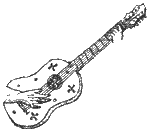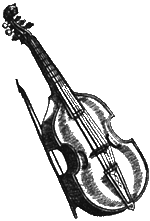
INSTRVMENTS:
|
For ages the human voice has been considered to be the most expressive and natural of any instrument and one to which all others are compared. This was especially true during the Renaissance when many writers and theorists would measure an instrument's worth by its ability to emulate the human voice. Part of the natural beauty of the voice is that it is completely organic and—unlike other musical instruments—is not an extension of the performer, but is rather an integral part of the performer and is therefore nearly "perfect." As new writers tried to push the existing boundaries of vocal ability and ornamantation vocal composition reflected astonishing leaps of beauty and emotion. |
|
The Renaissance lute is a plucked string instrument, strung in gut, and normally played with the fingers. The lute of the 16th century was as ubiquitous then as are the piano or guitar of today. It was highly valued for its versatility, portability, and ability to emulate vocal polyphony by being able to play multiple "voices" at once. This eventually led to very personal styles of interpretation and helped to propel the Renaissance ideal into new uncharted territories. Because of its ability to convey expressive feelings and work well with either voice, as a solo instrument, in duets, or in larger instrumental ensembles, the lute became the essential instrument for courtiers and laymen alike. |
 Renaissance guitar. |
The Renaissance guitar, while possessing the same name as its modern descendant, was a substantially different instrument. Having only four courses (pairs) of gut strings, it was often small and lacked a true bass register. Nearly as versatile as the lute, it was often an instrument of choice for song accompaniment, ensembles, and easy dance pieces. However, in the hands of a master (such as famed 16th century lutenist Albert de Rippe), the music could be transformed into the most complicated of fantasies or intabulations that explore (and exploit) the entire range of the instrument. |
 Renaissance cittern. |
The Renaissance cittern is one of a few metal-strung plectrum-plucked instruments from the Renaissance. Generally of only four courses (pairs) of strings, the cittern uses a range of only a major 6th between its lowest and highest strings, and employs a "re-entrant" tuning. (For more detailed information, see http://cittern.theaterofmusic.com.) The tuning and narrow range allow the player a number of simple chord shapes useful for both simple song accompaniment and dances, and its bright and cheerful timbre make it a valuable counterpoint to gut-strung instruments. |
 Renaissance vihuela. |
The Renaissance vihuela, similar to the Renaissance guitar, is a waisted instrument of between five and seven courses (but usually employing six). Similar to the lute in tuning, it was primarily used in Spain as a replacement for the lute which, some believe, was avoided because of the lute's possible Moorish ties. Unlike the lute, the vihuela is usually strung with unison courses. The manner of playing more closely resembles modern guitar with its "thumb out" technique, although the "thumb under" technique was also known (but referred to as "la manera estranjera"—the "foreign manner"). |
 Renaissance viol. |
Strung in gut like its plucked relatives, the Renaissance viol plays an important role in Renaissance ensemble music. The viol is usually played with a bow, meaning that the individual voices in polyphonic arrangements can be sustained much like an actual voice. (By contrast, the lute and other plucked instruments have a very limited ability to sustain a note; as a result, these instruments usually use multiple notes or "divisions" in order to create the illusion of sustained voices.) The viol was used in a variety of ways: in "whole consorts" of viols, in "broken consorts" of mixed instruments, and as a solo instrument in its own right. |
 Harp. |
Of all the early instruments, the harp is probably one of the most familiar "early" instruments to audiences today. The harp has existed in several forms in terms of the number of strings and size, but the basic structure of the instrument as used in the Renaissance (triangular frame with single strings running between a beam and a soundboard) has remained nearly unchanged since its use nearly 1,200 years ago. One of the outstanding and best-known qualities of the harp is the continuous ringing of the unstopped strings, which adds an "airy" quality to any musical piece. |


